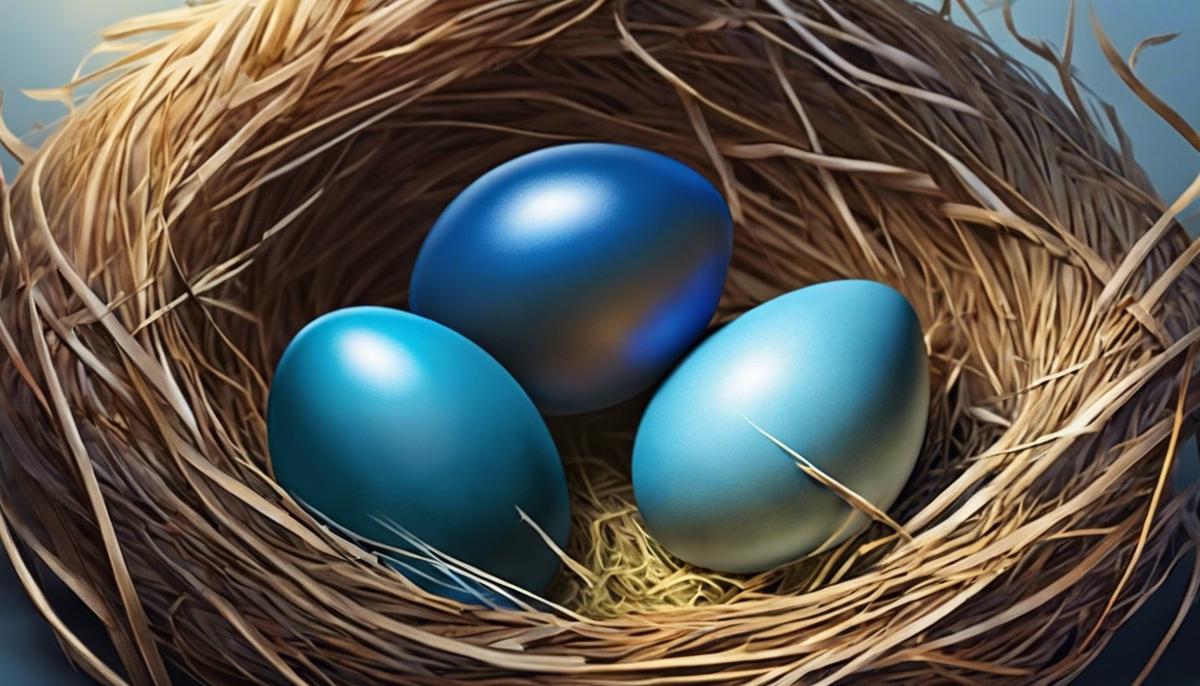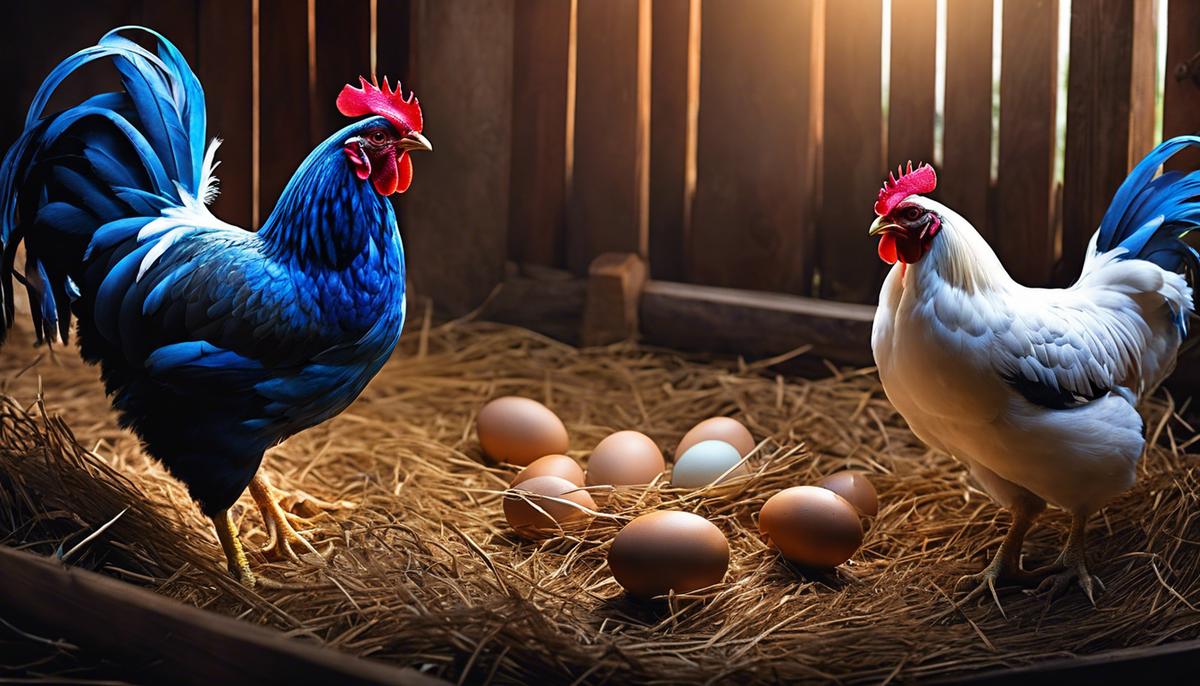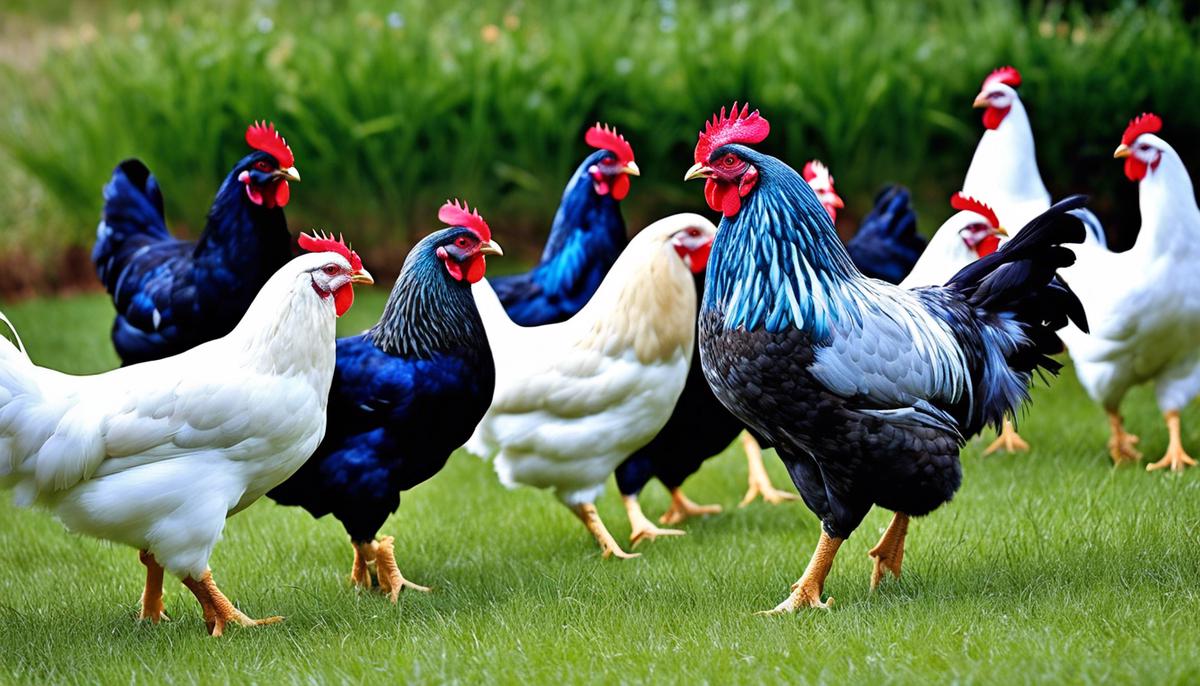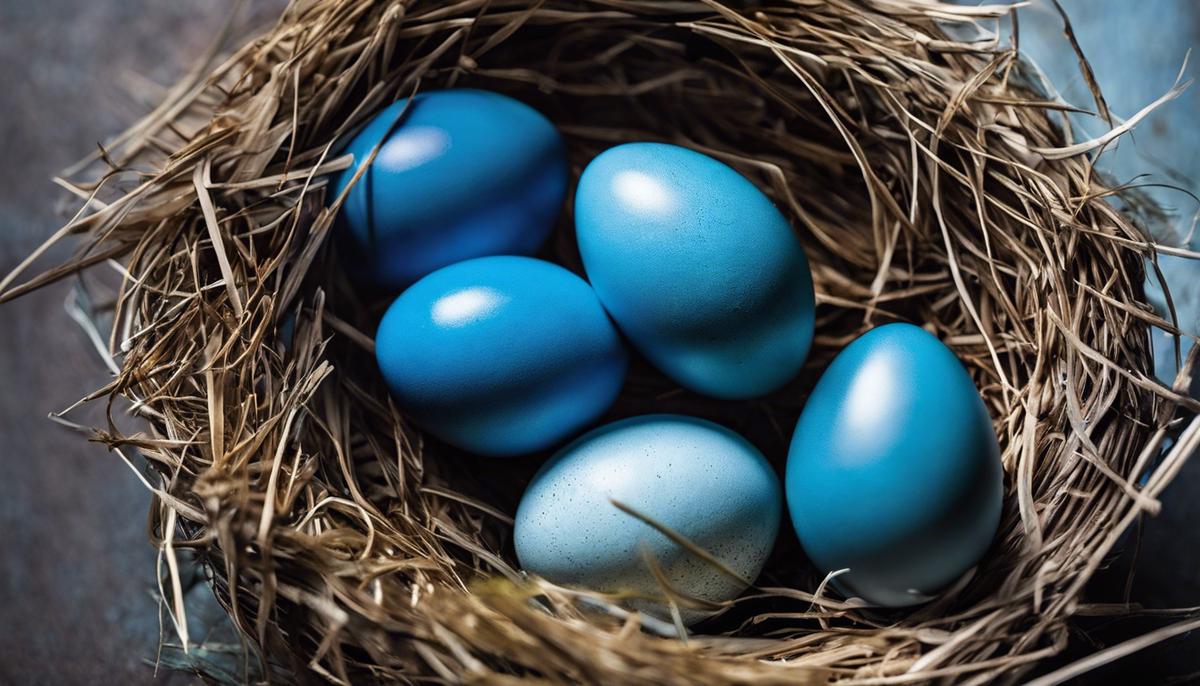
All About Blue Eggs Chicken Breeds
Description: In the wonderful world of poultry, a handful of chicken breeds captures the fascination of hobbyists and poultry enthusiasts alike -- those that lay the unconventional, eye-catching blue eggs. The origins and history of these blue egg-laying chicken breeds take us on a global journey, from ancient poultry habitats to purposeful breeding practices that shaped chicken genetics across centuries. Equally intriguing are their distinctive characteristics that set them apart, both aesthetically and behaviorally. Understanding these could provide a peek into why they lay such uniquely hued eggs. This exploration will not be complete without tackling some of the most common blue egg-laying chicken breeds, including Ameraucanas, Araucanas, Cream Legbars, and Easter Eggers. But beyond their vibrant eggs and interesting histories, one must also know the nuances of raising and caring for these breeds. Lastly, this exploration will delve into the debunking of common myths about these incredible birds. Let's embark on this journey to demystify the blue egg-laying chickens and their colorful world. If you've ever had the chance to visit a local farmer's market, you've likely come across a delightful sight — blue chicken eggs. Even though they might startle a keen observer, they are just as natural and nutritious as any other egg. However, it's a lesser known fact that blue eggs are laid by a specific chicken breed with a fascinating backstory. Let's pull back the curtain to reveal the refreshing tale of blue egg-laying chickens. Blue eggs laid by chickens are a wonder of genetics and can be traced back to two primary breeds: The Araucana and The Ameraucana, which originate from South America. Furthermore, blue eggs aren’t just a myth or fabulous marketing strategy based on dyeing. No, the blue egg genetic code is entirely different from that of brown or white eggs. The mystical Araucanas, often referred to as the "South American rumpless," are indigenous to Chile. These unique birds flaunt tuffs of feathers near their ears, not to mention their quirky lack of tail feathers. It is this breed that has been credited for the blue egg phenomena. However, to reveal the blue magic starts not at the shell, but deep within the egg formation process itself. The blue color is a result of the pigment oocyanin, which is expelled from the chicken's system as it forms the egg, permeating through the entire egg shell. This mechanism is quite different from brown eggs that have their color caused by protoporphyrin IX, a pigment only added to the shell’s surface just before laying. Araucanas were imported to the United States in the 1920s and met with enthusiastic reception amongst poultry enthusiasts. But with inbreeding issues and the difficulty of producing chicks with the desired ear tufts, breeders were set with a challenge. This, however, didn't douse the enthusiasm around these blue egg-shelling chickens. Breeders then decided on mixing in other breeds to create a more robust blue egg-laying chicken, resulting in what we now know as the Ameraucana breed in the 1970s. Ameraucanas are recognized for their full tail and muffs, a patch of fluffy feathers around their ears, adding to their strikingly distinctive looks. And of course, the magnificent blue eggs they bring to the breakfast table. So, the next time you come across a blue egg, be sure to appreciate the fabulous genetics and specialized breeding journey that these wonder-layers have been through. From the mystical coasts of Chile, through rigorous selection and breeding programs, blue egg-laying chickens have marked a unique spot in the poultry world with their vibrant, colorful eggs. Not only do they display beauty in diversity but also serve as a testament to the fascinating wonders of nature that never fails to astound us. Simply put, they are an emblem of the countless possibilities that exist within the realm of genetics and poultry breeding! While it's no secret that chickens can lay eggs of various colors, from the typical white and brown to the more exotic green and blue shades, identifying the breeds with the unique ability to produce blue eggs remains a subject that continuously fascinates both seasoned poultry farmers and hobbyists alike. Although the blue eggs' distinctive hue has been largely attributed to the breed's South American origins and the pigment oocyanin, separating fact from fiction can be a little more complex. Firstly, when discussing blue egg-laying chicken breeds, it's impossible to ignore the Cream Legbar, renowned not just for its capacity to produce gorgeous pastel-blue eggs, but also for its sex-linked color attribute, which allows growers to determine the gender of chicks immediately after hatching. This British breed, developed in the early 20th century by Reginald Crundall Punnett and Michael Pease, is a cross between Araucanas, barred Plymouth Rocks, and Browns Leghorns. It's essential for those looking to add blue eggs to their chicken coops without venturing into the domain of the demanding Araucanas or the complex nature of Ameraucanas. Equally enchanting is the Whiting True Blue. Among the newer breeds in the poultry scene, these hardy layers can produce a consistent supply of blue eggs. Their robust genetic diversity helps to improve laying ability and overall health compared to older blue egg breeds. This not only makes them an appealing option for backyard breeders but also showcases the ongoing innovation and crossbreeding efforts in the poultry world to perfect the genetic sequence necessary for producing blue eggs. For backyard enthusiasts seeking a layer of large blue eggs, the Sapphire Gem is a fantastic contender. Despite its beautiful name, the Sapphire Gem isn't a recognized breed but a hybrid chicken. Originally developed in Slovakia, the breed is loved for its prolific and reliable egg-laying capabilities, making it an excellent choice for those passionate about blue eggs. In exploring the tenacity, invention, and poultry genetics that led to the cultivation of blue egg-laying chickens, it is clear there are vibrant and lesser-known options beyond the Araucanas and Ameraucanas out there. Moreover, appreciating the beauty and uniqueness of blue eggs inevitably leads to a further exploration of the poultry world's vastness and diversity. Isn't it remarkable how a seemingly simple goal to create a chicken breed that lays blue eggs can lead to such a stunning display of genetic diversity and resilience? It's these breathtaking revelations that make the world of poultry breeding a consistently fascinating pursuit. Dive further into the fascinating world of blue egg-laying hens, beyond the already discussed Araucana and Ameraucana varieties. Other breeds also possess the uncanny ability and the mesmerizing genetic makeup to produce vibrantly blue eggs that dazzle the eye and brighten up the egg carton. While the South American Araucana and Ameraucana breeds are somewhat well-known for their blue egg-laying trait, an enduring favorite among poultry enthusiasts is the Cream Legbar. Hailing from Britain, this attractive breed is not only an excellent blue egg layer but also carries the unique characteristic of auto-sexing. This term might sound fancy, but it simply means that you can distinguish male chicks from females as soon as they hatch based on their color patterns, a trait that proves exceedingly handy for breeders and flock keepers. Not too far behind in the blue egg-laying game is the Whiting True Blue, an American breed as unique as it is functional. This breed's immense genetic diversity makes it a standout; it's a powerhouse layer, consistently producing a generous quantity of eggs year-round. Their hues range from light pastel blues to deeper, richer blues, making their egg production interesting as well as abundant. The Sapphire Gem breed is a superstar hybrid chicken worth mentioning in the blue egg-laying circle. While technically a hybrid rather than a recognized breed, Sapphire Gems are renowned for their large and fairly consistent blue egg-laying prowess. These chickens offer an exceptional combination of beauty and production, serving as a testament to the wonders of poultry genetics. Even among these diverse breeds, it's important to remember that not every chicken of these breeds will lay blue eggs; the capability depends on their specific genetic strains. But for those who do, they carry the complex legacy of breeders who worked tirelessly to stimulate and perfect this fascinating trait. Each blue egg laid is a tribute to the doggedness of selective breeding and the fascinating journey of genetics. They signify the extraordinary diversity within the poultry world, reminding us that even common farm animals carry within them the potential for dazzling uniqueness. So, whether you’re a poultry keeper or an egg aficionado, there’s more than meets the eye when it comes to these blue egg-laying marvels. Navigating through an exciting world of poultry keeping promises tremendous reward, especially when dealing with the unique blue egg-laying chickens. Beyond the mesmerizing hues of their eggs and their captivating backgrounds, knowing how to raise and care for these unique birds ensures a fulfilling and productive hobby. Starting from scratch, opting for day-old chicks is the most common way to introduce these chickens into one's flock. Young chicks undoubtedly require a greater level of attention and commitment to their well-being, yet the bonds formulated throughout their growth are priceless. Essential needs such as brooding temperatures, appropriate feed, clean water, and safe housing must be diligently met. As they mature, their dietary, housing, and healthcare needs will progressively change, so it's vital to be well-versed in chicken maintenance basics. Proper nutrition is key in maintaining the health of your blue egg-layers, especially if your primary aim is prolific egg production. Specialty feed designed for layers usually packs the right mix of nutrients like calcium that's needed for the creation of strong, healthy eggshells. Likewise, offering your hens a selection of vegetables, fruits, and other kitchen scraps supplements their diet and can enhance egg quality. However, avoid feeding them certain foods such as avocados, chocolate, or raw beans which can be harmful to their health. Blue egg-laying breeds are notably hardy, but they are not immune to potential health problems. Hence, regular health checks are a must. Look out for common signs of disease such as lethargy, droopy wings, and changes in eating or laying habits. Familiarizing oneself with common chicken ailments and their symptoms can equip one to handle periods of illness effectively and timely. Socialization plays a substantial role in the overall well-being of any flock. Chickens are social creatures and should never be housed alone. Allowing them to mingle with other backyard birds maintains their emotional health. However, remember to always introduce new chickens gradually to prevent possible tension and bullying. Now, let's touch on accommodation. Your blue egg-layers will greatly appreciate a comfy and safe coop. Providing plenty of nesting space ensures a quiet, private, and dark place for egg laying. Each hen needs about 1 square foot of nesting space. Furthermore, an adequate outdoor run allows your chickens to engage in natural behaviors such as scratching and pecking. Safeguarding your coop with predator-resistant features is also vital. Remember the mantra: 'Happy hens lay many eggs.' To keep your blue egg-laying hens content, providing an environment that caters to their comfort, safety, and health needs will go a long way. Raising these chickens is not just about the joy of finding blue eggs in the nesting box. It's about feeling a peaceful satisfaction amidst the thrills of poultry-keeping, and knowing that by extending a part of yourself to these birds, the rewards will be countless and painted in shades of blue. Embarking on a journey to understanding blue egg-laying chickens can be a bit tricky with all the misleading information swirling in the whirlwind of poultry talk. Let's unscramble a few misconceptions, while stuffing your mental nest-box with some useful insight. Myth 1: All blue egg-laying chickens are Ameraucanas or Araucanas This couldn't be further from the truth. The Ameraucana and Araucana are indeed known for their blue egg-laying prowess, but they're not alone kith and kin in the blue egg-laying party. Other breeds like the Cream Legbar, Sapphire Gem, and Whiting True Blue also join this unique poultry parade. Each of these breeds has distinct characteristics, but they all share that exciting gene oocyanin, which graces their eggs with that captivating blue hue. Myth 2: Every chicken within these breeds lays blue eggs While it's true that these breeds can lay blue eggs, not every hen will. It comes down to genetics. Within these breeds, some specific genetic strains have caught the blue egg trait, while others skip it altogether. Remember, nature often loves to show that she likes to mix and dull the predictable paint. Myth 3: Blue eggs taste different Despite the colorful hype, the reality is that the color of an egg doesn't dictate its taste — it's all about the hen's diet. Irrespective of the breed, hens that dabble in the freedom of outdoors natural foraging and enjoy high-quality feed brim their eggs with rich, flavorful yolks. Myth 4: Blue eggs are nutritionally superior Again, the egg's color doesn't tell the tale of what's brimming inside. Nutrition in eggs links more closely to the hen's diet and lifestyle than to breed or egg color. Myth 5: Blue egg-laying chickens are tougher to raise While each breed may hold some peculiarities, raising blue egg-layers isn't any more challenging than raising brown or white egg-layers. Providing optimal housing conditions, nutritious feed, clean water, and regular health checks will pave the pathway to your flock's wellbeing. A happy, healthy chicken leads to a plentiful, vibrant egg basket! So, by now you can see that the fascination with blue eggs literally runs more than shell deep. Yes, they bring an element of magic and wonder to the egg basket, but the beauty of these blue egg-layers goes beyond the color of their eggs. It thrives on the diversity they bring to the barnyard, the august demonstration of genetics at play, and the affirmation that variety truly is the spice of life, or should we say eggs! Sticky blue misperceptions unpeeled, let's celebrate the truth and beauty of our blue egg-laying feathery friends. So, the fascinating world of blue egg-laying chickens is a tapestry of rich history, distinctive characteristics, a variety of breeds, and practical care tips. From their global origins to the everyday management of their breed, these chickens introduce a touch of color, not just in their eggs but also in the realm of poultry raising. The myths and misconceptions surrounding them were also unraveled, which emphasizes the importance of factual understanding in this hobby. Regardless, whether one is a poultry enthusiast, a budding hobbyist, or a seasoned breeder, the blue egg-laying chickens offer more than their novelty. They represent nature's creativity, the endless possibilities of selective breeding, and the delightful surprises in farming. So let’s appreciate these birds for what they truly are — unique, colorful, and undoubtedly charming additions to our backyards.All about blue eggs chicken breeds
Origins and History of Blue Egg-Laying Chickens
The Fascinating Backstory of Blue Egg-laying Chickens

Characteristics of Blue Egg-Laying Chickens
Unlocking the Secrets of Blue Egg-laying Chicken Breeds

Common Blue Egg-Laying Chicken Breeds

Raising and Caring for Blue Egg-Laying Chickens
Caring for Blue Egg-Laying Chickens: Your Comprehensive Guide

Debunking Common Myths About Blue Egg-Laying Chickens
Hatching Misconceptions: The Truth about Blue Egg-Laying Chickens
